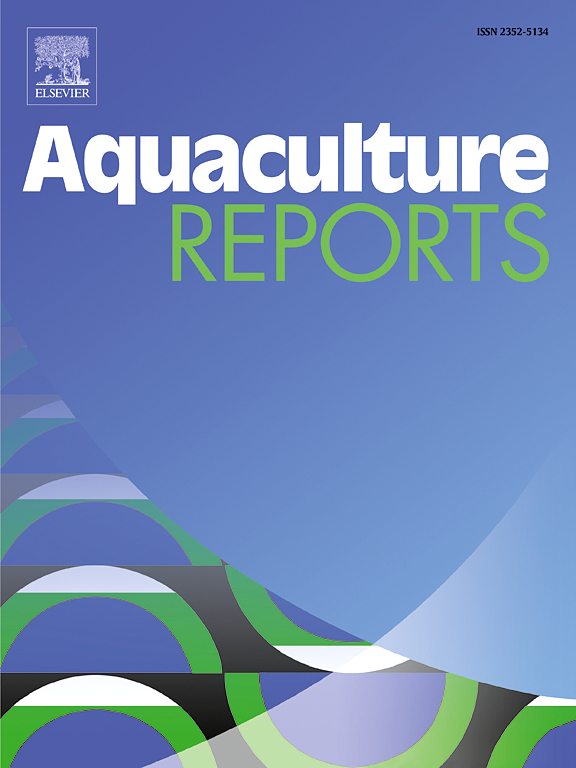低盐度养殖条件下由大坝光杆菌亚种(Photobacterium damselae subsp.damselae)引起的太平洋南美白对虾(Litopenaeus vannamei)虾病的研究
IF 3.2
2区 农林科学
Q1 FISHERIES
引用次数: 0
摘要
苍虾病是一种新出现的严重疾病,影响泰国南部低盐度地区的太平洋南美白对虾(Litopenaeus vannamei)幼体。最显著的临床症状是体色均匀苍白,严重病例的死亡率接近 100%。本研究旨在确定这种疾病的致病因子。研究人员从自然疫情池塘中收集受影响的对虾进行疾病调查。经证实,该病具有传播性,因为摄食受影响的对虾表现出身体苍白的特征。为证明该病的细菌病因,从自然发病的对虾中分离出细菌,并使用 16S rRNA 基因测序进行鉴定。将纯培养物接种到健康对虾体内。在不同的细菌分离物(主要是弧菌属)中,只有大坝光杆菌亚种(PDD)会诱发身体苍白的临床症状。因此,在 10 ppt 条件下,通过浸泡(105 CFU/mL)和口服(107 CFU/虾)来检测 PDD 的致病性。第 7 天,受挑战的对虾体色苍白,两组的存活率分别为 53 % 和 10 %,而对照组对虾没有死亡。从组织学角度看,PDD 感染对虾的肝胰腺小管萎缩,淋巴器官球形化、肌病和肌肉中的血细胞浸润也很明显。这些组织病理学变化与自然疫情中观察到的变化基本一致。因此,我们的研究结果表明,神秘的苍白虾病是由 PDD 引起的,这是一种迄今未知的病原体,会导致对虾大量死亡。本文章由计算机程序翻译,如有差异,请以英文原文为准。
Investigation of pale shrimp disease in Pacific white shrimp (Litopenaeus vannamei) caused by Photobacterium damselae subsp. damselae in low salinity culture conditions
Pale shrimp disease is a serious emerging disease affecting juvenile Pacific white shrimp (Litopenaeus vannamei) in the low salinity areas of Southern Thailand. The most prominent clinical sign is a uniformly pale body coloration, with a mortality rate of nearly 100 % in severe cases. This study aimed to identify the causative agents of this disease. The affected shrimp from the natural outbreak ponds were collected for disease investigation. The disease was proven to be transmissible, as feeding-challenged shrimp showed pale body characteristics. To demonstrate the bacterial etiology of the disease, bacteria were isolated from naturally diseased shrimp and identified using 16S rRNA gene sequencing. Pure cultures were inoculated into healthy shrimp. Among the different bacterial isolates (mainly Vibrio spp.), only Photobacterium damselae subsp. damselae (PDD) induced clinical signs of a pale body. Thus, PDD was examined for pathogenicity via immersion (105 CFU/mL) and oral gavage (107 CFU/shrimp) at 10 ppt. On day 7, the challenged shrimp showed pale body coloration, and the survival rates of both groups were 53 % and 10 %, respectively, whereas no mortality was observed in the control shrimp. Histologically, the hepatopancreatic tubules of the PDD-infected shrimp were atrophic, and lymphoid organ spheroids, myopathy, and hemocytic infiltration in the muscle were also evident. These histopathological changes are generally consistent with those observed in natural outbreaks. Consequently, our findings revealed that the enigmatic pale shrimp disease is caused by PDD, a hitherto unknown pathogen that causes massive shrimp mortality.
求助全文
通过发布文献求助,成功后即可免费获取论文全文。
去求助
来源期刊

Aquaculture Reports
Agricultural and Biological Sciences-Animal Science and Zoology
CiteScore
5.90
自引率
8.10%
发文量
469
审稿时长
77 days
期刊介绍:
Aquaculture Reports will publish original research papers and reviews documenting outstanding science with a regional context and focus, answering the need for high quality information on novel species, systems and regions in emerging areas of aquaculture research and development, such as integrated multi-trophic aquaculture, urban aquaculture, ornamental, unfed aquaculture, offshore aquaculture and others. Papers having industry research as priority and encompassing product development research or current industry practice are encouraged.
 求助内容:
求助内容: 应助结果提醒方式:
应助结果提醒方式:


